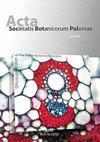Tocochromanols and fatty acid composition in flax (Linum usitatissimum L.) accessions
IF 0.8
4区 生物学
Q3 PLANT SCIENCES
引用次数: 4
Abstract
Flax, Linum usitatissimum, cultivars are grown throughout the world. Flax oil is a dietary source of polyunsaturated fatty acids, vitamin E, as well as phospholipids, sterols, and phenolic acids. Linseed plays a pivotal role in protecting cells from oxidative damage associated diseases, i.e., atherosclerosis, neurodegenerative disorders, cancer, and inflammation. In this study, two groups of L. usitatissimum seeds were used to evaluate and compare the content and composition of tocochromanols (vitamin E) and fatty acids. Group I included accessions originating from Poland and the Ukraine, while Group II encompassed worldwide flax cultivars (such as from the United States, Argentina, and Italy). A comparison of the tocochromanol profiles showed a higher content in Group I, although there were no significant differences in tocopherol content and composition between the genotypes within this group. All accessions in Groups I and II contained γ-tocotrienol and plastochromanol-8, which confirms the high nutritional value of flaxseeds. The composition of fatty acids varied depending on the varieties, with linolenic acid showing the greatest discrepancy. Based on the tocochromanol content and fatty acid composition, we conducted a principal component analysis (PCA) and cluster analysis, which revealed a greater similarity among the accessions in Group I. An analysis of the tocochromanol and fatty acid composition of flaxseeds is important from an agronomic and medicinal perspective and can be used to select the most appropriate flax cultivar.亚麻(Linum usitatissimum L.)中tocochromanol和脂肪酸组成
亚麻(Linum usitatissimum),栽培品种遍布世界各地。亚麻油是多不饱和脂肪酸、维生素E、磷脂、甾醇和酚酸的膳食来源。亚麻籽在保护细胞免受氧化损伤相关疾病(即动脉粥样硬化、神经退行性疾病、癌症和炎症)方面起着关键作用。本研究以两组枸杞子种子为研究对象,对枸杞子酚(维生素E)和脂肪酸的含量和组成进行了评价和比较。第一类包括来自波兰和乌克兰的品种,而第二类包括来自世界各地的亚麻品种(如来自美国、阿根廷和意大利)。对生育酚谱的比较显示,组1中生育酚含量较高,但组内各基因型间生育酚含量和组成无显著差异。第1组和第2组均含有γ-生育三烯醇和体质体醇-8,证实了亚麻籽具有较高的营养价值。脂肪酸的组成因品种而异,以亚麻酸差异最大。通过主成分分析(PCA)和聚类分析,发现类群亚麻种子中tocochromanol含量和脂肪酸组成具有较大的相似性。对亚麻种子中tocochromanol和脂肪酸组成的分析具有重要的农艺和药用价值,可用于选择最合适的亚麻品种。
本文章由计算机程序翻译,如有差异,请以英文原文为准。
求助全文
约1分钟内获得全文
求助全文
来源期刊
CiteScore
2.00
自引率
10.00%
发文量
18
审稿时长
1 months
期刊介绍:
The journal has been published since 1923 and offers Open Access publication of original research papers, short communications, and reviews in all areas of plant science, including evolution, ecology, genetics, plant structure and development, physiology and biochemistry.

 求助内容:
求助内容: 应助结果提醒方式:
应助结果提醒方式:


